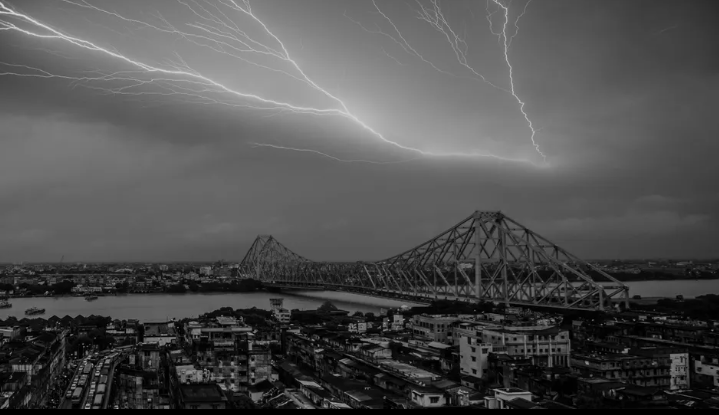Kalboishakhi’s Fading Echo: The Cultural and Environmental Shifts of Bengal’s Storm (GS Paper 1, Arts & Culture)

Context
- In the vibrant tapestry of Bengali culture, the term Kalboishakhi (কালবৈশাখী) once conjured images of dramatic sky changes, the onset of monsoon, and the comforting aroma of hot, fried snacks.
- The term, meaning "fateful storm" in the Bengali calendar month of Boishakh (April-May), was once a frequent topic of conversation, marking the arrival of the season's first major thunderstorms.
- Today, however, this traditional term is becoming increasingly rare, as climate change alters weather patterns and cultural practices.
Kalboishakhi: A Cultural Touchstone
- For many Bengalis, Kalboishakhi evokes more than just a weather phenomenon.
- It represents a cherished cultural experience—a time when the sky darkened, and the air crackled with the promise of rain.
- It was a season marked by the smell of gorom shingara (hot samosas) and beguni (brinjal fritters), and the comforting call of “Jhor ashche!” (a storm is coming) from the kitchen.
The Disappearing Storm
- Over recent years, Kalboishakhi has become increasingly unpredictable.
- The storms that once reliably marked the transition from scorching heat to the refreshing monsoon are now infrequent and erratic.
- This shift is a tangible consequence of climate change, which has not only altered weather patterns but also disrupted cultural traditions.
- The disruption of these weather patterns serves as a stark reminder of the broader environmental changes occurring globally.
- As temperatures rise and weather becomes less predictable, the cultural practices tied to these phenomena are also changing or disappearing.
The Impact of Climate Change on Cultural Heritage
- The loss of Kalboishakhi as a cultural marker is part of a larger trend of cultural erosion linked to environmental changes.
- Just as languages face extinction due to displacement and migration, cultural practices associated with specific environmental conditions are also at risk.
- American linguist W.Y. Leonard notes that climate change contributes to a "loss for words" in communities, as traditional terms and knowledge become obsolete in the face of changing environmental conditions.
- The term Kalboishakhi, once a symbol of seasonal change and cultural continuity, is at risk of becoming a relic of the past.
Literary Legacy and the Changing Storm
- Kalboishakhi has also left its mark on Bengali literature, serving as a rich metaphor for both natural and emotional turbulence.
- Rabindranath Tagore, in his poem ‘Borshosesh’, and Jibanananda Das, in ‘Banalata Sen’, have immortalized these storms as symbols of profound change and emotional depth.
- Tagore’s works, such as ‘Geetobitan’, which celebrated the six seasons of the Bengali calendar, are deeply intertwined with the rhythms of nature.
- Satyajit Ray’s film Charulata uses the storm as a metaphor for personal upheaval, reflecting its cultural significance.
- Similarly, modern poets and songwriters like Anupam Roy continue to use Kalboishakhi to explore human emotions, though the storms themselves are less frequent.
The Dual Loss: Language and Literature
- The vanishing of Kalboishakhi is emblematic of a broader cultural and literary void.
- As climate change reshapes our environment, it also disrupts the language and stories that once captured its essence.
- Amitav Ghosh has highlighted this gap, arguing that contemporary literature often overlooks environmental crises, reflecting a disconnect between our changing world and our cultural narratives.
- This dual loss—of language and literature—underscores the broader challenge of integrating environmental realities into our cultural consciousness.
- As traditional words and stories become obsolete, they take with them the nuanced understanding of our natural world that they once conveyed.
A Call for Cultural Reflection
- The disappearance of Kalboishakhi serves as a poignant reminder of the interconnectedness of language, culture, and environment.
- As we grapple with the impacts of climate change, it is crucial to recognize and preserve the cultural practices and knowledge that help us understand and relate to our environment.
- Efforts to document and celebrate these traditions, even as they evolve or fade, are essential.
- By doing so, we honor the rich tapestry of our cultural heritage and acknowledge the profound ways in which our changing environment shapes our collective identity.
Conclusion
- The fading presence of Kalboishakhi symbolizes a deeper, more troubling shift—one that reflects not just the changing climate but also the erosion of cultural and linguistic heritage intertwined with our environmental experiences.
- As traditional markers of seasonal cycles disappear, so too do the stories, metaphors, and emotions they once evoked.
- This loss calls for a conscious effort to bridge the gap between our evolving environment and our cultural narratives.
- By preserving and adapting our traditions to fit the new reality, we can ensure that the essence of what once was remains a part of who we are.
- In doing so, we not only honor our past but also create a foundation for a future where our cultural and environmental identities can coexist harmoniously.


